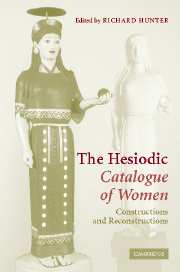Book contents
- Frontmatter
- Contents
- Notes on contributors
- Acknowledgements
- List of abbreviations
- Introduction
- 1 Ordering women in Hesiod's Catalogue
- 2 The beginning and end of the Catalogue of Women and its relation to Hesiod
- 3 Gods among men? The social and political dynamics of the Hesiodic Catalogue of Women
- 4 Heracles in the Hesiodic Catalogue of Women
- 5 Mestra at Athens: Hesiod fr. 43 and the poetics of panhellenism
- 6 A catalogue within a catalogue: Helen's suitors in the Hesiodic Catalogue of Women (frr. 196–204)
- 7 Pulp epic: the Catalogue and the Shield
- 8 The Megalai Ehoiai: a survey of the fragments
- 9 Ordered from the Catalogue: Pindar, Bacchylides, and Hesiodic genealogical poetry
- 10 The Hesiodic Catalogue and Hellenistic poetry
- 11 From genealogy to Catalogue: the Hellenistic adaptation of the Hesiodic catalogue form
- 12 The Hesiodic Catalogue of Women and Latin poetry
- 13 Or such as Ovid's Metamorphoses …
- Bibliography
- Index of passages discussed
- General index
10 - The Hesiodic Catalogue and Hellenistic poetry
Published online by Cambridge University Press: 22 September 2009
- Frontmatter
- Contents
- Notes on contributors
- Acknowledgements
- List of abbreviations
- Introduction
- 1 Ordering women in Hesiod's Catalogue
- 2 The beginning and end of the Catalogue of Women and its relation to Hesiod
- 3 Gods among men? The social and political dynamics of the Hesiodic Catalogue of Women
- 4 Heracles in the Hesiodic Catalogue of Women
- 5 Mestra at Athens: Hesiod fr. 43 and the poetics of panhellenism
- 6 A catalogue within a catalogue: Helen's suitors in the Hesiodic Catalogue of Women (frr. 196–204)
- 7 Pulp epic: the Catalogue and the Shield
- 8 The Megalai Ehoiai: a survey of the fragments
- 9 Ordered from the Catalogue: Pindar, Bacchylides, and Hesiodic genealogical poetry
- 10 The Hesiodic Catalogue and Hellenistic poetry
- 11 From genealogy to Catalogue: the Hellenistic adaptation of the Hesiodic catalogue form
- 12 The Hesiodic Catalogue of Women and Latin poetry
- 13 Or such as Ovid's Metamorphoses …
- Bibliography
- Index of passages discussed
- General index
Summary
LOOKING FOR THE CATALOGUE
Hesiod's importance for the poetry of the third-century bc is a familiar fact of literary history. Most famously, of course, Callimachus presents the Aitia as a Theogony for the modern day through the opening reworking of Hesiod's meeting with the Muses on Mt Helicon (frr. 3–4 Massimilla = frr. 1.41–5, 2 Pf.), thus himself laying claim to the title which his contemporary Hermesianax of Colophon bestowed upon Hesiod, πάσης ἤρανος ἱστορίης ‘keeper of all knowledge/research’ (Hermesianax fr. 7.22 Powell). Hesiod's most long-lasting influence on the Western poetic tradition, however, is mediated through the Phainomena of Aratus; in its own right, and through its multiple Latin translations, this poem on the constellations and weather-signs became one of the best known and most widely read of all classical texts in later antiquity and the Middle Ages. In the Phainomena, Hesiod (and, above all, the Works and Days) is a model as ubiquitously visible as the god's heavenly signs, in structure, language, form and meaning, and this relationship was celebrated by Callimachus in a famous, and very variously interpreted, epigram:
῾Ησιόδου τό τ᾿ ἄεισμα καὶ ὁ τρόπος· οὐ τὸν ἀοιδὸν
ἔσχατον, ἀλλ᾿ ὀκνέω μὴ τὸ μελιχρότατον
τῶν ἐπέων ὁ Σολεὺς ἀπέμαξατο· χαίρετε λεπταί
ῥήσεις, Ἀρήτου σύντονος ἀγρυπνίη.
Callimachus, Epigram 27 Pf.Hesiod's is the song and the style; not the poet in every detail, but I would say that the man from Soloi has skimmed off the sweetest of his verses. Hail subtle phrases, the concentrated wakefulness of Aratus!
- Type
- Chapter
- Information
- The Hesiodic Catalogue of WomenConstructions and Reconstructions, pp. 239 - 265Publisher: Cambridge University PressPrint publication year: 2005
- 6
- Cited by



